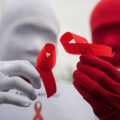Undetectable viral load for HIV. Is there a risk of infection?
In this article, you will learn more about what an undetectable viral load means and how you can find out your viral load.
What does an undetectable viral load mean for HIV?
Viral load is the amount of human immunodeficiency virus (HIV) contained in a person's blood. An undetectable viral load for HIV is the amount of virus in a person’s blood that is so low that tests cannot detect it.
Effective HIV treatment ( antiretroviral therapy ) suppresses the amount of HIV in the body to a level at which standard tests cannot detect HIV or can only detect very small amounts of it. In professional parlance, this is called “virological suppression.”
Although an undetectable viral load does not mean that HIV infection has been completely cured, it holds great promise for a person's overall health and reducing the risk of transmitting the virus to others.
However, we should not forget that the presence of an undetectable viral load does not mean that a person has been cured of HIV. If treatment is stopped, the viral load will increase and will again be detected and therefore transmitted.
During the first few weeks after HIV infection, the viral load is usually very high—several million “viral copies per milliliter of blood” (copies/ml). There is a significant risk of HIV transmission during this period. In fact, many people become infected with HIV from people who have recently become infected and do not know it.
After a period of early infection, the viral load usually decreases. The typical viral load in a person not taking treatment may be 50,000 copies/ml. However, there is still a significant risk of HIV transmission.
After starting treatment and taking the drugs correctly, the viral load begins to decrease. Within 3-6 months, the viral load of most HIV-infected people becomes undetectable (less than 50 copies/ml).
However, it is recommended to wait until you have had at least 2 consecutive test results with an undetectable viral load within six months before relying on it.
Risk of infection with undetectable viral load
The first large study to show that people with low viral loads are not infectious came from a study of 415 heterosexual couples in 2000. It was found that no HIV-positive partner with a viral load below 1500 copies/ml transmitted HIV.
In 2011, a large scientific study called HPTN 052 concluded that antiretroviral therapy reduced the risk of HIV transmission to a regular heterosexual partner by 96%. The reason the percentage was not 100 was because 1 person in the study did become infected with HIV, but it was within a few days of his partner starting treatment. Subsequently, during the four-year study, not a single person with an undetectable viral load transmitted HIV to their partner.
The latest results from the PARTNER 1 and PARTNER 2 studies were announced in 2016 and 2018. The study followed 972 same-sex couples and 516 heterosexual couples in which one partner had HIV and the other did not. In the study, same-sex couples had 77,000 acts of penetrative sex without condoms, and heterosexual couples had 36,000. The PARTNER studies found no cases of HIV transmission from an HIV-positive partner who had an undetectable viral load (below 200 copies / ml).
Thus, these studies confirmed that the risk of transmitting HIV to a sexual partner by a person with an undetectable viral load is statistically equivalent to 0.
However, people with an undetectable viral load sometimes experience what are called “flares” in their viral load. Their viral load increases from undetectable to low but detectable levels and then becomes undetectable again in the next test.
For example, the viral load may temporarily increase to 60 copies/ml or 150 copies/ml. But this should not be a cause for concern. Remember that in the PARTNER and Opposites Attract studies, "undetectable" was defined as below 200 copies/ml. These studies showed that transmission does not occur below this level.
Viral load tests
Doctors use viral load tests to find out whether a person's body is suppressed by the immunodeficiency virus or whether the HIV viral load is undetectable. Such tests are aimed at measuring the amount of HIV RNA in a person's blood.
The following tests are used to determine HIV viral load:
- PCR (polymerase chain reaction method);
- R-DNA (quantitative branched DNA method);
- NASBA (nucleic acid amplification method).
Viral load tests repeatedly replicate the virus found in a small blood sample to make it easier to quantify the virus. But because of this, the results of one test may not be very accurate.
As with CD4 cell counts, it is important to track the results of multiple sequential tests to get a comprehensive picture. Treatment decisions should not be made based on the results of a single viral load test.
A person taking antiretroviral drugs with a stable viral load usually undergoes these tests two to four times a year.
How do treatment and undetectable viral load help prevent HIV transmission?
HIV treatment, also called antiretroviral therapy (ART), works by controlling HIV replication in the body, meaning it reduces the ability of HIV to make copies of itself. When HIV replication is controlled, the viral load in the blood and body fluids decreases. Research suggests that as your viral load decreases, your risk of HIV transmission also decreases. When successful treatment reduces the viral load to undetectable levels, the risk of HIV transmission is virtually zero.
ART usually consists of a combination of at least three antiretroviral drugs taken daily. Newer HIV treatments are safer, simpler and more effective than earlier ones. The effectiveness of antiretroviral therapy is now so great that many people who begin timely treatment immediately after becoming HIV-positive have a normal life expectancy.
For most people, the virus becomes so well controlled that within 3 to 6 months of starting treatment, the amount of virus in their blood becomes undetectable. Most viral load tests cannot detect HIV in the blood if there are fewer than 40 to 50 copies of the virus per milliliter. However, the virus is still present in very low levels in the body when the viral load is undetectable.
Consistent and appropriate use of ART to maintain undetectable viral load includes:
- regular and correct use of antiretroviral drugs to achieve and maintain an undetectable viral load;
- Regular visits to your doctor to monitor your viral load and receive advice and support.
Regular testing and treatment for sexually transmitted infections (STIs) is also important because ART does not protect against STIs.
A person receiving ART should communicate with their doctor to determine an appropriate schedule for medical examinations and viral load monitoring.
However, not everyone's viral load becomes and remains undetectable during treatment. This most often occurs when a person skips or forgets to take medications, but it can also occur due to drug resistance or drug toxicity. When treatment fails, a person will not know that their viral load can be detected until they are tested.
Depending on the reason why treatment is not effective, a person may need to change treatment or receive advice on medication guidelines to reduce their viral load to undetectable levels.




